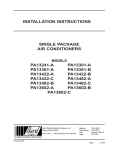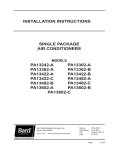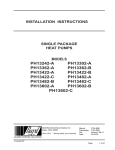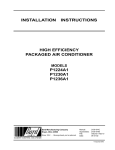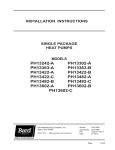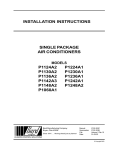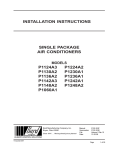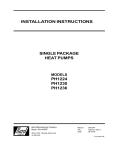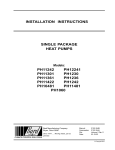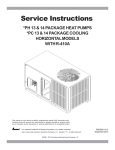Download Bard PA13421-A Specifications
Transcript
INSTALLATION INSTRUCTIONS SINGLE PACKAGE AIR CONDITIONERS MODELS PA13241-A PA13361-A PA13421-A PA13481-A PA13601-A PA13301-A PA13361-B PA13421-B PA13481-B PA13601-B Bard Manufacturing Company Bryan, Ohio 43506 Since 1914 . . . Moving ahead just as planned © Copyright 2006 Manual : Supersedes: File: Date: 2100-467 NEW Volume II Tab 10 03-03-06 Manual 2100-467 Page 1 of 23 CONTENTS Getting Other Informations and Publications ........ 3 General Instructions Important ................................................................ Shipping Damage .................................................... General ................................................................ Field Installed Heater Packages (Optional) ............. 4 4 4 4 Installation Location ................................................................ 9 Slab Mounting .......................................................... 9 Typical Installations ......................................... 9 & 12 Condensate Drain Trap ......................................... 12 Air Filters .............................................................. 12 Wiring – Main Power ............................................. 13 Wiring – 24V Low Voltage Control Circuit ............. 13 Transformer Taps ................................................... 13 Thermostats ........................................................... 13 Start Up and Operation General .............................................................. 15 Topping Off System Charge ................................... 15 Safety Practices ..................................................... 15 Start Up Notes ....................................................... 15 Three Phase Scroll Compressor Start Up Information ............................................................. 16 Sequence of Operation .......................................... 16 Indoor Blower Motor .............................................. 16 Compressor Control Module .......................... 16 & 17 Adjustments ........................................................... 17 Low Ambient Control ............................................. 17 Service and Troubleshooting Service Hints ......................................................... Pressure Service Ports .......................................... Refrigerant Charge ................................................ Fan Blade Settings ................................................ Suction and Discharge Tube Brazing .................... 18 18 18 18 19 Troubleshooting ECM Blower Motors ............. 20-21 Pressure Tables ............................................. 22 & 23 Figures Figure 1 Unit Dimensions ...................................... 8 Figure 2 Slab Mounting at Ground Level ............ 10 Figure 3 Airflow and Service Access Clearances ............................................ 10 Figure 4 Elevated Mounting Platform ................... 11 Figure 5 Condensate Drain Trap ......................... 12 Figure 6 Low Voltage Wiring ............................... 14 Figure 7 Low Ambient Control Wiring ................. 17 Figure 8 Fan Blade Setting ................................. 18 Figure 9 Brazing Diagram ................................... 19 Figure 10 Control Disassembly ............................. 21 Figure 11 Winding Test ......................................... 21 Figure 12 Drip Loop .............................................. 21 Manual 2100-467 Page 2 of 23 Tables Table 1 Table 2 Table 3 Table 4 Table 5 Table 6 Table 7 Rated CFM & ESP .................................. 4 Electrical Specifications .......................... 5 Opt. Field Installed Heater Packages ..... 6 Opt. Field Installed Elec. Heater ............. 7 Filter Requirements & Sizes ................. 12 Thermostat Wire Size ........................... 13 Wall Thermostat and Subbase Combinations ........................................ 13 Table 8 Refrigerant Charge ............................... 18 Table 9 Fan Blade Setting Dimensions .............. 18 Table 10 Indoor Blower Performance .................. 18 Table 11 Pressure Table ...................................... 22 Table 12 Pressure Table ...................................... 23 Getting Other Information and Publications These publications can help you install the air conditioner or heat pump. You can usually find these at your local library or purchase them directly from the publisher. Be sure to consult current edition of each standard. FOR MORE INFORMATION, CONTACT THESE PUBLISHERS: ACCA Air Conditioning Contractors of America 1712 New Hampshire Ave. N.W. Washington, DC 20009 Telephone: (202) 483-9370 Fax: (202) 234-4721 ANSI American National Standards Institute 11 West Street, 13th Floor New York, NY 10036 Telephone: (212) 642-4900 Fax: (212) 302-1286 National Electrical Code ...................... ANSI/NFPA 70 Standard for the Installation .............. ANSI/NFPA 90A of Air Conditioning and Ventilating Systems Standard for Warm Air ...................... ANSI/NFPA 90B Heating and Air Conditioning Systems Load Calculation for ............................ ACCA Manual J Residential Winter and Summer Air Conditioning Duct Design for Residential .............. ACCA Manual D Winter and Summer Air Conditioning and Equipment Selection ASHRAE American Society of Heating, Refrigerating, and Air Conditioning Engineers, Inc. 1791 Tullie Circle, N.E. Atlanta, GA 30329-2305 Telephone: (404) 636-8400 Fax: (404) 321-5478 NFPA National Fire Protection Association Batterymarch Park P.O. Box 9101 Quincy, MA 02269-9901 Telephone: (800) 344-3555 Fax: (617) 984-7057 Manual Page 2100-467 3 of 23 GENERAL INSTRUCTIONS IMPORTANT The equipment covered in this manual is to be installed by trained, experienced service and installation technicians. All duct work, supply and return ducts, must be properly sized for the design air flow requirement of the equipment. ACCA is an excellent guide to proper sizing. All duct work or portions thereof not in the conditioned space should be properly insulated in order to both conserve energy and prevent condensation or moisture damage. SHIPPING DAMAGE Upon receipt of equipment, the carton should be checked for external signs of shipping damage. If damage is found, the receiving party must contact the last carrier immediately, preferably in writing, requesting inspection by the carrier’s agent. FIELD INSTALLED HEATER PACKAGES (OPTIONAL) These packaged air conditioners are manufactured without supplementary electric heaters. Supplementary heaters are available for simple, fast field installation. A separate power circuit is required for the supplementary heaters. IMPORTANT: Refer to Table 1 when designing duct work for maximum available static pressure with heater installed. Refer to data shown in Table 3 and 4 for proper application information on all available heater combinations and what units they can be used with. It also shows the applicable circuit ampacities, fuse size, and wire size for each heater combination. GENERAL The refrigerant system is completely assembled and charged. All internal wiring is complete. The unit is designed for use with or without duct work. Flanges are provided for attaching the supply and return ducts. These instructions explain the recommended method to install the air cooled self-contained unit and the electrical wiring connections to the unit. These instructions and any instructions packaged with any separate equipment required to make up the entire system should be carefully read before beginning the installation. Note particularly “Starting Procedure” and any tags and/or labels attached to the equipment. While these instructions are intended as a general recommended guide, they do not supersede any national and/or local codes in any way. Authorities having jurisdiction should be consulted before the installation is made. Manual 2100-467 Page 4 of 23 TABLE 1 RATED CFM AND EXTERNAL STATIC PRESSURE (ESP) Model N o. Rated C FM Recommended Airflow Range Rated ESP Max. ESP PA13241 800 Note 0.18 0.50 PA13301 1000 Note 0.23 0.50 PA13361 1100 Note 0.23 0.50 PA13421 1400 Note 0.23 0.50 PA13481 1550 Note 0.28 0.50 PA13601 1650 Note 0.28 0.50 NOTE: ECM motors provide rated CFM up to 0.50 ESP Manual Page 2100-467 5 of 23 15 9 12 12 20 Minimum Circuit Ampacity BC SC Field Wire Size * Ground Wire Size Delay Fuse – Max. ** 7.5/8.5 48/48 Rated Load Amps Lock Rotor Amps PA13361-A PA13361-B PA13421-A * VS = Variable Speed Programmable Motor 300 350 350 300 Shipping Weight (pounds) 120 4.3 160 120 3.3 1/2 - VS 24"/3400 1.5 1/4 - 825 115/115 11.8/13.7 230/208 Scroll 16.2/18.1 50 10 10 21 31 197 - 253 1400/.23 85 3.3 1/2 - VS 24" / 1.1 1/6 - 825 75/75 7.6/8.9 230/208 Recip. 17.0/13.3 30 12 12 10 17 187 - 253 75 2.7 1/2 - VS 24"/2600 1.1 1/6 - 825 74/74 12/14 230/208 Recip. 16.4/18.4 35 8 8 15 24 197 - 253 Charge (R-410 oz.) 2.2 1/2 - VS 24"/2600 1.1 1/6 - 825 57/57 9.5/11 230/208 Recip. 13.3/14.8 25 10 10 11 18 197 - 253 CFM Cooling & ESP Blower Motor – Amps Blower Motor – HP/RPM * 1/3 - VS 24"/2700 Fan – Dia./CFM Motor and Evaporator 1.1 Fan Motor Amps Fan Motor – HP/RPM 1/6 - 825 230/208 Volts Fan Motor and Condenser Recip. Compressor Type Compressor – Circuit A 10.8/11.8 197 - 253 Total unit Amps – 230/208 PA13301-A PA13421-B PA13481-A PA13481-B PA13601-A PA13601-B 160 1400/.23 4.3 1/2 - VS 24"/3400 1.5 1/4 - 825 115/115 8.3/9.6 230/208 Scroll 14.1/15.4 40 10 10 15 23 187 - 253 160 1500/.28 4.5 3/4 - VS 24"/3400 1.5 1/4 - 825 117/117 17/18.7 230/208 Scroll 23.0/24.7 55 8 8 22 34 197 - 253 160 1500/.28 4.5 3/4 - VS 24"/3400 1.5 1/4 - 825 83.1/83.1 10.9/12 230/208 Scroll 16.9/18.0 40 10 10 14 24 187 - 253 160 1700/.28 4.7 3/4 - VS 24"/3400 1.5 1/4 - 825 134/134 19.3/22.9 230/208 Scroll 25.3/28.9 60 8 8 26 38 197 - 253 160 1700/.28 4.7 3/4 - VS 24"/3400 1.5 1/4 - 825 110/110 11.7/13.9 230/208 Scroll 17.7/19.9 40 10 10 16 26 187 - 253 230/208-60-1 230/208-60-1 230/208-60-1 230/208-60-3 230/208-60-1 230/208-60-3 230/208-60-1 230/208-60-3 230/208-60-1 230/208-60-3 PA13241-A Operating Voltage Range Electric Rating – 60 Hz – Circuit A Model TABLE 2 ELECTRICAL SPECIFICATIONS Manual 2100-467 Page 6 of 23 Volts & P h ase 240/208-1 240/208-1 240/208-1 240/208-3 240/208-3 240/208-1 240/208-1 240/208-1 240/208-3 240/208-3 Heater Package Model EHP313-A05 EHP313-A10 EHP313-A15 EHP313-B09 EHP313-B15 EHP513-A05 EHP513-A10 EHP513-A15 EHP513-B09 EHP513-B15 X X X X X X X X X X X X X X X X X X X X X X X X X PA13241-A PA13301-A PA13361-A PA13361-B PA13421-A PA13421-B PA13481-A PA13481-B PA13601-A PA13601-B TABLE 3 OPTIONAL FIELD INSTALLED HEATER PACKAGES ONLY TO BE USED WITH THE MODELS INDICATED Manual Page 2100-467 7 of 23 5 240/208-1 240/208-1 240/208-1 240/208-1 240/208-1 240/208-1 240/208-3 240/208-3 240/208-3 240/208-3 EHP313-A05 EHP313-A10 EHP313-A15 EHP513-A05 EHP513-A10 EHP513-A15 EHP313-B09 EHP313-B15 EHP513-B09 EHP513-B15 51,200 30,700 51,200 30,700 51,200 11.25 6.75 11.25 6.75 11.25 7.50 3.75 17,100 34,100 11.25 7.50 3.75 KW 51,200 34,100 17,100 B TU H 38,400 23,000 38,400 23,000 38,400 26,000 12,800 38,400 26,000 12,800 B TU H 36.2/31.2 21.7/18.7 36.2/31.2 21.7/18.7 62.5/54.1 41.6/36.2 20.8/18.1 62.5/54.1 41.6/36.2 20.8/18.1 240/208V Htr. Amps None None 30/60 30/60 Heater Internal Circuit Breaker 1 1 1 1 1 1 1 1 1 1 No. Field Circuits 30/25 50/40 46/39 50/40 46/39 28/24 30/25 80/70 79/68 28/24 60/50 30/25 53/46 26/23 80/70 60/50 53/46 79/68 30/25 1 Max. Over Current Protection 26/23 3 Min. Circuit Ampacity Circuit B 8/8 10/10 8/8 10/10 4/4 6/8 10/10 4/4 6/8 10/10 2 Field P o w er Wiring 10 10 10 10 8 10 10 8 10 10 Ground Wire Siz e 2 IMPORTANT: While this electrical data is presented as a guide, it is important to electrically connect properly sized fuses and conductor wires in accordance with the National Electrical Code and all existing local codes. 3 These “Minimum Circuit Ampacity” values are to be used for sizing the field power conductors. Refer to the National Electric Code (latest revision), Article 310 for power conductor sizing. 2 Based on wire suitable for 75°C. Other wiring materials must be rated for marked “Minimum Circuit Ampacity” or greater. Based on 75°C copper wire. All wiring must conform to the National Electric Code and all local codes. 1 Maximum size of the time delay fuse or HACR circuit breaker for protection of field wiring devices. 15 9 15 9 15 10 5 15 10 KW Unit Volts P h ases Heater P ackag e Model No. Htr. KW & Capacity Htr. KW & Capacity @ 240 Volts @ 208 Volts TABLE 4 OPTIONAL FIELD INSTALLED ELECTRIC HEATER TABLE FIGURE 1 DIMENSIONS OF UNITS W L A D E B Compressor access door Control panel door High voltage knockout Low voltage knockout Heater package knockout Supply opening C Heater package access panel Drain access Return opening F Condenser fan H Condenser air intake grille Blower motor access door 47 11/16" G Condenser air intake grille Unit Dimension Chart Unit PA/PH1324,1330,1336 PA/PH1342,1348,1360 Supply Size A C 5.875 32.875 9.875 37.875 Return Size B C 13.875 32.875 15.875 37.875 Unit Overall Dimensions H (height) L (length) W (width) 26.25 53.25 38.125 33.25 55.25 42.375 D 23.25 30.25 Unit General Dimensions E F G 1.125 1.375 35.625 1.5 2.375 38.125 MIS-2142 Manual 2100-467 Page 8 of 23 INSTALLATION LOCATION GENERAL The unit must be located outside, or in a well ventilated area. It must not be in the space being heated or cooled. A sound absorbing material should be considered if the unit is to be installed in such a position or location that might cause transmission of sound or vibration to the living area or adjacent buildings. SLAB MOUNTING A minimum of 24 inches should be provided between the coil inlet and any building surfaces. Provide a minimum of three feet clearance on the service access side of the unit. See Figure 2. TYPICAL INSTALLATIONS 1. ROOF MOUNTED – The unit is mounted on a sturdy base on the roof of the building. Return air to the unit is brought through a single return grille (grilles with built-in filters are best since they enable easy access for filter changing). Return air ducts are attached to the lower section of the front panel. Supply air is brought from the unit to attic duct work or to a furred down hall. Supply air duct is attached to the top of the front panel. In roof top installation, as in all installations, the air conditioner must be level from side to side. However, the unit should have a pitch along the length to assure complete external drainage of precipitation and of defrost condensate. 2. CRAWL SPACE – Duct work installed in crawl space must be well insulated and provided with a vapor barrier. In addition, the crawl space must be thoroughly ventilated and provided with a good vapor barrier as a ground cover. It is most desirable to install the unit will be outdoors rather than inside the crawl space, so that it will be readily accessible for service. 3. SLAB MOUNTED AT GROUND LEVEL – This type installation is ideal for homes with a slab floor construction where a roof mounted unit is not desired. The supply and return duct work can be run through a furred closet space. 4. THROUGH THE WALL – This type installation requires a suitable framework to be fabricated capable of withstanding the unit weight. Normally the unit will be insulated so as to minimize supply and return duct work. CAUTION: All outdoor duct work must be thoroughly insulated and weatherproofed. All attic duct work must be thoroughly insulated. Two inch thick insulation with suitable vapor barrier is recommended for both outdoor and attic runs. Manual Page 2100-467 9 of 23 FIGURE 2 SLAB MOUNTING AT GROUND LEVEL 1 inch clearance between duct and any combustible material if distance between outside wall and unit is less than 3 feet (needed on electric heat units only). The distance between outside wall and unit varies with installation requirements. Side View Air Outlet Package Unit Supply Duct Mounting Slab Return Duct 1/4 inch per foot slope away from building Ground Level Building FIGURE 3 AIRFLOW AND SERVICE ACCESS CLEARANCES Nearest Structure 36" min. Compressor Access Control Panel Compressor Blower and Blower Motor Blower Service Access Top View 24" min. Air Inlet Supply and Return Ducts Building Heater Package Control Panel Access Nearest Structure Heater Package Access Condenser fan and motor access from top. Leave 60" min. above fan. 24" min. Air Inlet Nearest Structure Manual 2100-467 Page 10 of 23 MIS-2143 FIGURE 4 ELEVATED MOUNTING PLATFORM * 12" min. if in 32°F or lower climate 48" min. Poured concrete, brick, or block Platform can be as shown or solid Both legs must rest on surface of platform * 12" min. if in 32°F or lower climate 48" min. Metal frame Both legs must rest on surface of platform MIS-2144 * AS REQUIRED Manual Page 2100-467 11 of 23 5. OTHER INSTALLATIONS – Many other installations are possible with the packaged air conditioner. No matter what the installation, always consider the following facts: A. Insure that the discharge air is not obstructed in any way so as to cause operation difficulties. B. The indoor coil drain pan is equipped with a coupling that must be piped through a condensate drain trap to a suitable drain. C. Always mount the unit is such a position that it may be easily reached for servicing and maintenance. D. Insure that the unit is clear so that proper air flow over the outdoor coil will be maintained. If this unit is operated in cooling below a 55° outdoor ambient temperature, the installation of low ambient controls (CMA-28) to unit is required. CONDENSATE DRAIN TRAP It is very important to provide a trap in the condensate drain line to allow a positive liquid seal in the line and assure correct drainage from the coil condensate pan. Install condensate drain trap shown in Figure 8. Use drain connection size or larger. Do not operate unit without trap. Unit must be level or slightly inclined toward drain. With a trap installed on a unit located in an unconditioned area, water in the trap may freeze. It is recommended that the trap material be of a type that will allow for expansion of water when it freezes. Prior thought should be given to return air location and placement of the air filter(s). The air filter(s) must be of adequate size and readily accessible to the operator of the equipment. Filters must be adequate in size and properly maintained for proper operation. If this is not done, excessive energy use, poor performance, and multiple service problems will result. It is impossible to oversize air filters. Generous sizing will result in cleaner air and coils as well as lower operating costs and extend the time between required changes. Table 5 shows minimum filter areas and recommended filter sizes. Actual filter sizes can vary with the installation due to single or multiple returns utilizing a filter/grille arrangement or being placed immediately ahead of the indoor coil face in the return air duct. TABLE 5 FILTER REQUIREMENTS & SIZES Model No. Minimum Filter Area Recommended Siz e PA1324 PA1330 PA1336 462 Square Inches (3.21 Square Feet) 15 x 30-5/8 x 1 PA1342 PA1348 PA1360 608 Square Inches (4.62 Square Feet) (2) 16 x 20 x 1 NOTE: If roof hood accessory is to be used, information on air filters may be found under that heading in this manual. Air filters are supplied as part of that package. AIR FILTERS Air filters for the return air side of the system are not provided as part of these models, and must be field supplied and installed as part of the final installation. FIGURE 5 CONDENSATE DRAIN TRAP MIS-136 Manual 2100-467 Page 12 of 23 TABLE 6 THERMOSTAT WIRE SIZE WIRING – MAIN POWER Refer to the unit rating plate for wire sizing information and maximum fuse size. Each outdoor unit is marked with a “Minimum Circuit Ampacity”. This means that the field wiring used must be sized to carry that amount of current. If field installed heaters are added to the basic unit, a second separate power supply circuit will be required. The heater rating plate located adjacent to the basic unit rating plate will show the appropriate circuit ampacity fuse size, etc. (Also see “Electrical Specifications” on pages 5 & 7.) All models are suitable for connection with copper wire only. These instructions must be adhered to. Refer to the National Electrical Code for complete current carrying capacity data on the various insulation grades of wiring material. The electrical specifications list fuse and wire sizes (75°F copper) for all models including the most commonly used heater sizes. The unit rating plate lists a “Maximum Time Delay Fuse” or “HACR” type circuit breaker that is to be used with the equipment. The correct size must be used for proper circuit protection and also to assure that there will be no nuisance tripping due to the momentary high starting current of the compressor. WIRING – 24V LOW VOLTAGE CONTROL CIRCUIT Transformer VA 55 FLA Wire Gauge 2.3 Maximum Distance In Feet 20 18 16 14 12 45 60 100 160 250 TRANSFORMER TAPS 230/208V, 1 phase and 3 phase equipment employ dual primary voltage transformers. All equipment leaves the factory wired on 240V tap. For 208V operation, reconnect from 240V to 208V tap. The acceptable operating voltage range for the 240 and 208V taps are: TAP RANGE 240 253 – 216 208 220 – 187 NOTE: The voltage should be measured at the field power connection point in the unit and while the unit is operating at full load (maximum amperage operating condition). Five (5) wires should be run from thermostat subbase to the 24V terminal board in the unit. A five conductor, 18 gauge copper, color-coded thermostat cable is recommended. The connection points are shown in Figure 6. THERMOSTATS See specific wiring information for the different models, heater KWs, and voltages on unit and heating wiring diagrams. TABLE 7 WALL THERMOSTAT AND SUBBASE COMBINATIONS Thermostat S u b b ase Predominant Features 8403-049 1F93-380 —— 2 stage heat, 2 stage cool, Electronic Programmable 8403-042 T8511G1070 —— 2 stage heat, 1 stage cool, System: Heat-off-cool-Auto Fan: on-auto Electronic Non-Programmable 8403-048 T8400C1313 —— 1 stage heat, 1 stage cool, System: Heat-off-cool Fan: on-auto Electronic Non-Programmable IMPORTANT NOTE: Only the thermostat and subbase combinations as shown above will work with this equipment. The thermostat and subbase MUST be matched, and correct operation can be assured only by proper selection and application of these parts. Manual Page 2100-467 13 of 23 FIGURE 6 LOW VOLTAGE WIRING Thermostat Subbase IF93-380 C G R Y1 Y2 B W1 W2 W3 A1 C G R Y B W1 W2 G R Y G R Y E2 P L E L E L E D OR T8511G1070 OR T8400C1313 Unit 24V Terminal Block C W Y1 B W1 W2 W3 DH D1 REMOVE JUMPER FOR 2 STAGE ELECTRIC HEAT ON UNITS WITH 15 OR MORE KW Unit Control Panel MIS-2149 Manual 2100-467 Page 14 of 23 START UP These units require R-410A refrigerant and polyolester oil. GENERAL: 1. Use separate service equipment to avoid cross contamination of oil and refrigerants. 2. Use recovery equipment rated for R-410A refrigerant. 3. Use manifold gauges rated for R-410A (800 psi/250 psi low). 4. R-410A is a binary blend of HFC-32 and HFC-125. 5. R-410A is nearly azeotropic - similar to R-22 and R-12. Although nearly azeotropic, charge with liquid refrigerant. 6. R-410A operates at 40-70% higher pressure than R-22, and systems designed for R-22 cannot withstand this higher pressure. SAFETY PRACTICES: 1. Never mix R-410A with other refrigerants. 2. Use gloves and safety glasses, polyolester oils can be irritating to the skin, and liquid refrigerant will freeze the skin. 3. Never use air and R-410A to leak check; the mixture may become flammable. 4. Do not inhale R-410A – the vapor attacks the nervous system, creating dizziness, loss of coordination and slurred speech. Cardiac irregularities, unconsciousness and ultimate death can result from breathing this concentration. 5. Do not burn R-410A. This decomposition produces hazardous vapors. Evacuate the area if exposed. 6. Use only cylinders rated DOT4BA/4BW 400. 7. Never fill cylinders over 80% of total capacity. 7. R-410A has an ozone depletion potential of zero, but must be reclaimed due to its global warming potential. 8. Store cylinders in a cool area, out of direct sunlight. 8. R-410A compressors use polyolester oil. 10. Never trap liquid R-410A in manifold sets, gauge lines or cylinders. R-410A expands significantly at warmer temperatures. Once a cylinder or line is full of liquid, any further rise in temperature will cause it to burst. 9. Polyolester oil is hygroscopic; it will rapidly absorb moisture and strongly hold this moisture in the oil. 10. A liquid line dryer must be used - even a deep vacuum will not separate moisture from the oil. 11. Limit atmospheric exposure to 15 minutes. 12. If compressor removal is necessary, always plug compressor immediately after removal. Purge with small amount of nitrogen when inserting plugs. 9. Never heat cylinders above 125°F. START UP NOTES For improved start up performance, wash the indoor coil with dishwasher detergent. TOPPING OFF SYSTEM CHARGE If a leak has occurred in the system, Bard Manufacturing recommends reclaiming, evacuating (see criteria above), and charging to the nameplate charge. Topping off the system charge can be done without problems. With R-410A, there are no significant changes in the refrigerant composition during multiple leaks and recharges. R-410A refrigerant is close to being an azeotropic blend (it behaves like a pure compound or single component refrigerant). The remaining refrigerant charge, in the system, may be used after leaks have occurred and then “top-off” the charge by utilizing the charging charts on the inner control panel cover as a guideline. REMEMBER: When adding R-410A refrigerant, it must come out of the charging cylinder/tank as a liquid to avoid any fractionation, and to insure optimal system performance. Refer to instructions for the cylinder that is being utilized for proper method of liquid extraction. Manual Page 2100-467 15 of 23 START UP AND OPERATION THREE PHASE SCROLL COMPRESSOR START UP INFORMATION position and the blower is already in operation, then the motor will ramp up to the required speed for cooling. (PA1336, 42, 48 and 60 Models) HEATING (1st Stage) – On a call for heating from the room thermostat (circuit R-W1 makes), the blower will energize (circuit R-G is automatic when R-W1 makes). This will place the system into heating operation to maintain the thermostat set temperature. Note that if the “Fan” switch on the room thermostat is in the “On” position and the blower is already in operation, then the motor will ramp up to the required speed for heating. Scroll compressors, like several other types of compressors, will only compress in one rotational direction. Direction of rotation is not an issue with single phase compressors since they will always start and run in the proper direction. However, three phase compressors will rotate in either direction depending upon phasing of the power. Since there is a 50-50 chance of connecting power in such a way as to cause rotation in the reverse direction, verification of proper rotation must be made. Verification of proper rotation direction is made by observing that suction pressure drops and discharge pressure rises when the compressor is energized. Reverse rotation also results in an elevated sound level over that with correct rotation, as well as, substantially reduced current draw compared to tabulated values. HEATING (2nd Stage) – If the operation of the 1st Stage electric heaters will not maintain the set room temperature, then the thermostat will call for additional heat to help maintain the set temperature. On a call for second stage heating from the room thermostat (circuit R-W2 makes), additional electric heaters will be energized if installed. Verification of proper rotation must be made at the time the equipment is put into service. If improper rotation is corrected at this time there will be no negative impact on the durability of the compressor. However, reverse operation for over one hour may have a negative impact on the bearing due to oil pump out. INDOOR BLOWER MOTOR NOTE: If compressor is allowed to run in reverse rotation for several minutes the compressor’s internal protector will trip. On command from the wall thermostat the motor will start slowly and ramp up to full speed over a period of 10- 15 seconds. All three phase scroll compressors are wired identically internally. As a result, once the correct phasing is determined for a specific system or installation, connecting properly phased power leads to the same Fusite terminals should maintain proper rotation direction. When the thermostat is satisfied the blower will operate for approximately 1 minute, and then slow down and stop. The direction of rotation of the motor may be changed by reversing any two line connections to the unit. SEQUENCE OF OPERATION BLOWER ONLY – When the “Fan” switch on the room thermostat is placed in the “On” position (circuit R-G makes), the blower will energize and run until the “Fan” switch is placed back into the “Auto” position. This will allow for constant air circulation at a lower airflow during times when the unit is not in operation for cooling or heating. COOLING – On a call for cooling from the room thermostat (circuit R-Y makes), the blower will energize (circuit R-G is automatic when R-Y makes) as well as the compressor, and outdoor fan motor. Note that if the “Fan” switch on the room thermostat is in the “On” Manual 2100-467 Page 16 of 23 Some models feature a variable speed (ECM) motor providing high efficiency, low sound levels and soft start capabilities. The motor is self adjusting to provide the proper air flow rate at duct static pressures up to 0.50" WC without user adjustment or wiring changes. COMPRESSOR CONTROL MODULE The compressor control is an anti-short cycle/lockout timer with high and low pressure switch monitoring and alarm output. ADJUSTABLE DELAY-ON-MAKE AND BREAK TIMER On a call for compressor operation the delay-on-make period begins which will be 10% of the delay-on-break setting. When the delay-on-make is complete and the high pressure switch (and low pressure switch if employed) is closed, the compressor contactor is energized. Upon shutdown the delay-on-break timer starts and prevents restart until the delay-on-break and delay-on-make periods have expired. HIGH PRESSURE SWITCH AND LOCKOUT SEQUENCE (Standard Feature) LOW AMBIENT CONTROL If the high pressure switch opens, the compressor contactor will de-energize immediately. The lockout timer will go into a soft lockout and stay in soft lockout until the high pressure switch closes and the delay-onmake time has expired. If the high pressure switch opens again in this same operating cycle the unit will go into manual lockout condition and the alarm circuit will energize. Recycling the wall thermostat resets the manual lockout. Optional Low Ambient Control LOW PRESSURE SWITCH, BYPASS, AND LOCKOUT SEQUENCE (Standard Feature) If the low pressure switch opens for more that 120 seconds, the compressor contactor will de-energize and go into a soft lockout. Regardless the state of the low pressure switch, the contactor will reenergize after the delay-on-make time delay has expired. If the low pressure switch remains open or opens again for longer than 120 seconds the unit will go into manual lockout condition and the alarm circuit will energize. Recycling the wall thermostat resets the manual lockout. An optional low ambient control is available for both factory and field installed options. The low ambient control is to be applied to the PA13 Series models when operation below 55°outdoor conditions are anticipated. Without this device, the evaporating pressure would fall off, and the indoor coil would ice over. The fan cycling control cycles the fan motor on, once the liquid refrigerant pressure reaches 350 psig, and off, once it has dropped to 225 psig. It will continue to cycle between these parameters depending on outdoor temperatures and the load/stage of the system. This cycling maintains a minimum liquid pressure affecting the minimum suction pressure. This effect insures an evaporating temperature that is slightly above the point of ice formation on the evaporator. This field installed option is Bard Part #CMA-28. See Figure 7. ALARM OUTPUT Alarm terminal is output connection for applications where alarm signal is desired. This terminal is powered whenever compressor is locked out due to HPC or LPC sequences as described. FIGURE 7 LOW AMBIENT CONTROL WIRING NOTE: Both high and low pressure switch controls are inherently automatic reset devices. The high pressure switch and low pressure switch cut out and cut in settings are fixed by specific air conditioner or heat pump unit model. The lockout features, both soft and manual, are a function of the Compressor Control Module. ADJUSTMENTS ADJUSTABLE DELAY-ON-MAKE AND DELAY-ON-BREAK TIMER The potentiometer is used to select Delay-on-Break time from 30 seconds to 5 minutes. Delay-on-Make (DOM) timing on power-up and after power interruptions is equal to 2 minutes plus 10% of Delay-on-Break (DOB) setting: 0.5 minute 1.0 minute 2.0 minute 3.0 minute 4.0 minute 5.0 minute (30 seconds) (60 seconds) (120 seconds) (160 seconds) (240 seconds) (300 seconds) DOB DOB DOB DOB DOB DOB = = = = = = 123 second DOM 126 second DOM 132 second DOM 138 second DOM 144 second DOM 150 second DOM Manual Page 2100-467 17 of 23 SERVICE AND TROUBLESHOOTING SERVICE HINTS FAN BLADE SETTINGS 1. Caution homeowner to maintain clean air filters at all times. Also, not to needlessly close off supply and return air registers. This reduces air flow through the system which shortens equipment service life as well as increasing operating costs. Shown in Figure 8 are the correct fan blade setting dimensions for proper air delivery across the outdoor coil. 2. Check all power fuses or circuit breakers to be sure that they are the correct rating. Any service work requiring removal or adjustment in the fan and/or motor area will require that the dimensions below be checked and blade adjusted in or out on the motor shaft accordingly. 3. Periodic cleaning of the outdoor coil to permit full and unrestricted airflow circulation is essential. FIGURE 8 FAN BLADE SETTING PRESSURE SERVICE PORTS High and low pressure service ports are installed on all units so that the system operating pressures can be observed. Pressure tables can be found later in this manual covering all models on cooling cycle. It is imperative to match the correct pressure table to the unit by model number. "B" “A” REFRIGERANT CHARGE MD-1417BC TABLE 9 FAN BLADE SETTING DIMENSIONS The correct system R-410A charge is shown on the unit rating plate. Model TABLE 8 REFRIGERANT CHARGE Dimension "A" PA1324 Model Rated Airflow 95° OD Temperature 82° OD Temperature PA1330 PA1324 800 96-97 83-84 PA1342 PA1330 1000 94-95 82-83 PA1348 PA1336 1100 97-98 85-86 PA1360 PA1342 1400 98-99 85-86 PA1348 1550 98-99 85-86 PA1360 1650 101-102 88-89 The above liquid line temperatures are based upon 80°F dry bulb/67° wet bulb (50% RH) temperatures and rated airflow across the evaporator during cooling cycle. PA1336 3¼" TABLE 10 INDOOR BLOWER PERFORMANCE 1 Model Rated ESP MAX ESP 2 3 4 Continuous Airflow Rated Cooling C FM Rated Heating C FM PA1324 0.10 0.50 600 800 800 PA1330 0.15 0.50 750 1000 1000 PA1336 0.15 0.50 825 1100 1100 PA1342 0.20 0.50 925 1400 1400 PA1348 0.20 0.50 1025 1550 1550 PA1360 0.20 0.50 1150 1650 1650 1 Motor will deliver consistent CFM through voltage supply range with no deterioration (197-253V for all 230/208V models). 2 Continuous CFM is the total air being circulated during continuous (manual fan) mode. 3 Will occur automatically with a call for "Y" for cooling mode operation. 4 Will occur automatically with a call for "W1" for heating mode operation. Manual 2100-467 Page 18 of 23 – Reinsert tube into fitting. SUCTION AND DISCHARGE TUBE BRAZING Compliant Scroll compressors have copper plated steel suction and discharge tubes. These tubes are far more rugged and less prone to leaks than copper tubes used on other compressors. Due to different thermal properties of steel and copper, brazing procedures may have to be changed from those commonly used. • To disconnect: heat joint Areas 2 and 3 slowly and uniformly until braze material softens and the tube can be pulled out of suction fitting. (See Figure 9.) – Heat tube uniformly in Area 1 moving slowly to Area 2. When joint reaches brazing temperature, apply brazing material. (See Figure 9) – Heat joint uniformly around the circumference to flow braze material completely around the joint. – Slowly move torch into Area 3 to draw braze material into joint. (See Figure 9.) – Do not overheat joint. • To connect: – Recommended brazing materials: silfos with minimum 5% silver or silver braze material with flux. FIGURE 9 BRAZING DIAGRAM MIS-1179 Manual Page 2100-467 19 of 23 TROUBLESHOOTING GE ECM™ MOTORS CAUTION: Disconnect power from unit before removing or replacing connectors, or servicing motor. To avoid electric shock from the motor’s capacitors, disconnect power and wait at least 5 minutes before opening motor. Symptom Cause/Procedure • Noisy blower or cabinet • Check for loose blower housing, panels, etc. • High static creating high blower speed? - Check for air whistling through seams in ducts, cabinets or panels - Check for cabinet/duct deformation Symptom Cause/Procedure Motor rocks slightly when starting • This is normal start-up for ECM • “Hunts” or “puffs” at high CFM (speed) • Does removing panel or filter reduce “puffing”? - Reduce restriction - Reduce max. airflow Motor won’t start • No movement • Check blower turns by hand • Check power at motor • Check low voltage (24 Vac R to C) at motor • Check low voltage connections (G, Y, W, R, C) at motor • Check for unseated pins in connectors on motor harness • Test with a temporary jumper between R - G • Check motor for tight shaft • Perform motor/control replacement check • Perform Moisture Check • Motor rocks, but won’t start • Check for loose or compliant motor mount • Make sure blower wheel is tight on shaft • Perform motor/control replacement check Motor oscillates up & down while being tested off of blower • It is normal for motor to oscillate with no load on shaft Motor starts, but runs erratically • Varies up and down or intermittent • Check line voltage for variation or “sag” • Check low voltage connections (G, Y, W, R, C) at motor, unseated pins in motor harness connectors • Check “Bk” for erratic CFM command (in variable-speed applications) • Check out system controls, Thermostat • Perform Moisture Check Evidence of Moisture • Motor failure or malfunction has occurred and moisture is present • Replace motor and Perform Moisture Check • Evidence of moisture present inside air mover • Perform Moisture Check Do Don’t • Check out motor, controls, wiring and connections thoroughly before replacing motor • Orient connectors down so water can’t get in - Install “drip loops” • Use authorized motor and model #’s for replacement • Keep static pressure to a minimum: - Recommend high efficiency, low static filters - Recommend keeping filters clean. - Design ductwork for min. static, max. comfort - Look for and recommend ductwork improvement, where necessary • Automatically assume the motor is bad. • Size the equipment wisely • “Hunts” or “puffs” at high CFM (speed) • Does removing panel or filter reduce “puffing”? - Reduce restriction - Reduce max airflow • Stays at low CFM despite system call for cool or heat CFM • Check low voltage (Thermostat) wires and connections • Verify fan is not in delay mode; wait until delay complete • “R” missing/not connected at motor • Perform motor/control replacement check • Stays at high CFM • “R” missing/not connected at motor • Is fan in delay mode? - wait until delay time complete • Perform motor/control replacement check • Check orientation before inserting motor connectors • Locate connectors above 7 and 4 o’clock positions • Replace one motor or control model # with another (unless an authorized replacement) • Use high pressure drop filters some have ½" H20 drop! • Use restricted returns • Oversize system, then compensate with low airflow • Plug in power connector backwards • Force plugs Moisture Check • Blower won’t shut off • Current leakage from controls into G, Y or W? Check for Triac switched thermostat or solidstate relay Excessive noise • Determine if it’s air noise, cabinet, duct or motor noise; interview customer, if necessary • High static creating high blower speed? - Is airflow set properly? - Does removing filter cause blower to slow down? Check filter - Use low-pressure drop filter - Check/correct duct restrictions • Air noise Manual 2100-467 Page 20 of 23 • Connectors are oriented “down” (or as recommended by equipment manufacturer) • Arrange harness with “drip loop” under motor • Is condensate drain plugged? • Check for low airflow (too much latent capacity) • Check for undercharged condition • Check and plug leaks in return ducts, cabinet Comfort Check • Check proper airflow settings • Low static pressure for lowest noise • Set low continuous-fan CFM • Use humidistat and 2-speed cooling units • Use zoning controls designed for ECM that regulate CFM • Thermostat in bad location? TROUBLESHOOTING GE ECM™ MOTORS Cont’d. Replacing ECM Control Module To replace the control module for the GE variable-speed indoor blower motor you need to take the following steps: 1. You MUST have the correct replacement module. The controls are factory programmed for specific operating modes. Even though they look alike, different modules may have completely different functionality. USING THE WRONG CONTROL MODULE VOIDS ALL PRODUCT WARRANTIES AND MAY PRODUCE UNEXPECTED RESULTS. 2. Begin by removing AC power from the furnace or air handler being serviced. DO NOT WORK ON THE MOTOR WITH AC POWER APPLIED. To avoid electric shock from the motor’s capacitors, disconnect power and wait at least 5 minutes before opening motor. 3. It is usually not necessary to remove the motor from the blower assembly. However, it is recommended that the whole blower assembly, with the motor, be removed from the furnace/air handler. (Follow the manufacturer’s procedures). Unplug the two cable connectors to the motor. There are latches on each connector. DO NOT PULL ON THE WIRES. The plugs remove easily when properly released. 4. Locate the two standard ¼" hex head bolts at the rear of the control housing (at the back end of the control opposite the shaft end). Refer to Figure 10. Remove these two bolts from the motor and control assembly while holding the motor in a way that will prevent the motor or control from falling when the bolts are removed. If an ECM2.0 control is being replaced (recognized by an aluminum casting rather that a deep-drawn black steel can housing the electronics), remove only the hex-head bolts. DO NOT REMOVE THE TORX-HEAD SCREWS. 5. The control module is now free of mechanical attachment to the motor endshield but is still connected by a plug and three wires inside the control. Carefully rotate the control to gain access to the plug at the control end of the wires. With thumb and forefinger, reach the latch holding the plug to the control and release it by squeezing the latch tab and the opposite side of the connector plug and gently pulling the plug out of the connector socket in the control. DO NOT PULL ON THE WIRES. GRIP THE PLUG ONLY. 6. The control module is now completely detached from the motor. Verify with a standard ohmmeter that the resistance from each motor lead (in the motor plug just removed) to the motor shell is >100K ohms. Refer to Figure 11. (Measure to unpainted motor end plate.) If any motor lead fails this test, do not proceed to install the control module. THE MOTOR IS DEFECTIVE AND MUST BE REPLACED. Installing the new control module will cause it to fail also. 7. Verify that the replacement control is correct for your application. Refer to the manufacturer's authorized replacement list. USING THE WRONG CONTROL WILL RESULT IN IMPROPER OR NO BLOWER OPERATION. Orient the control module so that the 3-wire motor plug can be inserted into the socket in the control. Carefully insert the plug and press it into the socket until it latches. A SLIGHT CLICK WILL BE HEARD WHEN PROPERLY INSERTED. Finish installing the replacement control per one of the three following paragraphs, 8a, 8b or 8c. 8a. IF REPLACING AN ECM 2.0 CONTROL (control in cast aluminum can with air vents on the back of the can) WITH AN ECM 2.3 CONTROL (control containing black potting for water protection in black deep-drawn steel case with no vents in the bottom of the can), locate the two through-bolts and plastic tab that are packed with the replacement control. Insert the plastic tab into the slot at the perimeter of the open end of the can so that the pin is located on the inside of the perimeter of the can. Rotate the can so that the tab inserts into the tab locater hole in the endshield of the motor. Using the two through-bolts provided with the replacement control, reattach the can to the motor. THE TWO THROUGH-BOLTS PROVIDED WITH THE REPLACEMENT ECM 2.3 CONTROL ARE SHORTER THAN THE BOLTS ORIGINALLY REMOVED FROM THE ECM 2.0 CONTROL AND MUST BE USED IF SECURE ATTACHMENT OF THE CONTROL TO THE MOTOR IS TO BE ACHIEVED. DO NOT OVERTIGHTEN THE BOLTS. 8b. IF REPLACING AN ECM 2.3 CONTROL WITH AN ECM 2.3 CONTROL, the plastic tab and shorter through-bolts are not needed. The control can be oriented in two positions 180° apart. MAKE SURE THE ORIENTATION YOU SELECT FOR REPLACING THE CONTROL ASSURES THE CONTROL'S CABLE CONNECTORS WILL BE LOCATED DOWNWARD IN THE APPLICATION SO THAT WATER CANNOT RUN DOWN THE CABLES AND INTO THE CONTROL. Simply orient the new control to the motor's endshield, insert bolts, and tighten. DO NOT OVERTIGHTEN THE BOLTS. 8c. IF REPLACING AN ECM 2.0 CONTROL WITH AN ECM 2.0 CONTROL (It is recommended that ECM 2.3 controls be used for all replacements), the new control must be attached to the motor using through-bolts identical to those removed with the original control. DO NOT OVERTIGHTEN THE BOLTS. 9. Reinstall the blower/motor assembly into the HVAC equipment. Follow the manufacturer's suggested procedures. 10. Plug the 16-pin control plug into the motor. The plug is keyed. Make sure the connector is properly seated and latched. 11. Plug the 5-pin power connector into the motor. Even though the plug is keyed, OBSERVE THE PROPER ORIENTATION. DO NOT FORCE THE CONNECTOR. It plugs in very easily when properly oriented. REVERSING THIS PLUG WILL CAUSE IMMEDIATE FAILURE OF THE CONTROL MODULE. 12. Final installation check. Make sure the motor is installed as follows: a. Unit is as far INTO the blower housing as possible. b. Belly bands are not on the control module or covering vent holes. c. Motor connectors should be oriented between the 4 o’clock and 8 o’clock positions when the blower is positioned in its final location and orientation. d. Add a drip loop to the cables so that water cannot enter the motor by draining down the cables. Refer to Figure 12. The installation is now complete. Reapply the AC power to the HVAC equipment and verify that the new motor control module is working properly. Follow the manufacturer's procedures for disposition of the old control module. Figure10 3 Figure Control Disassembly Figure 411 Figure Winding Test Motor Connector (3-pin) Only remove From Motor Hex Head Bolts Push until Latch Seats Over Ramp Circuit Board Motor ECM 2.0 Motor OK when R > 100k ohm Note: Use the shorter bolts and alignment pin supplied when replacing an ECM 2.0 control. Figure 12 5 Figure Drip Loop ECM 2.3/2.5 Motor Connector (3-pin) Back of Control Connector Orientation Between 4 and 8 o'clock Control Connector (16-pin) Power Connector (5-pin) Hex-head Screws Drip Loop Manual Page 2100-467 21 of 23 Manual 2100-467 Page 22 of 23 131 256 141 265 Low S i de High Side Low S i de High Side Low S i de High Side Low S i de High Side Low S i de High Side Low S i de High Side Low S i de High Side Low S i de High Side 80° D B 67° WB 85° D B 72° WB 75° D B 62° WB 80° D B 67° WB 85° D B 72° WB 75° D B 62° WB 80° D B 67° WB 85° D B 72° WB 133 282 124 272 116 265 146 279 136 270 127 263 122 250 Low S i de High Side 75° D B 62° WB 65° Pressure Return Air Temperature LOW SIDE PRESSURE +2 PSIG HIGH SIDE PRESSURE +5 PSIG PA1336 PA1330 PA1324 Model COOLING 141 325 131 314 122 306 149 322 139 311 130 303 147 306 137 296 128 289 75° 144 348 134 336 125 328 151 344 140 332 131 324 149 329 139 318 130 310 80° 148 372 138 359 129 350 153 368 142 356 133 347 153 352 142 340 133 332 85° 151 396 140 383 131 373 155 392 144 379 135 370 156 377 145 364 136 355 90° 154 422 143 408 134 398 157 418 146 404 137 394 158 402 147 388 137 378 95° (Continued on Page 23 in Table 12) 138 303 128 293 120 286 147 300 137 290 128 283 144 286 134 276 125 269 70° TABLE 11 PRESSURE TABLE 156 448 145 433 136 422 159 444 148 429 138 418 160 427 149 413 139 403 100° 158 475 147 459 137 448 162 471 151 455 141 444 162 454 151 439 141 428 105° 160 502 149 485 139 473 164 499 153 482 143 470 163 482 152 466 142 454 110° 161 530 150 512 140 499 168 529 156 511 146 498 166 511 154 494 144 482 115° 163 560 152 541 142 527 171 559 159 540 149 527 167 541 155 523 145 510 120° 164 590 153 570 143 556 174 589 162 569 151 555 169 571 157 552 147 538 125° Air Temperature Entering Outdoor Coil Degree F Manual Page 2100-467 23 of 23 Pressure Low S i de High Side Low S i de High Side Low S i de High Side Low S i de High Side Low S i de High Side Low S i de High Side Low S i de High Side Low S i de High Side Low S i de High Side Return Air Temperature 75° D B 62° WB 80° D B 67° WB 85° D B 72° WB 75° D B 62° WB 80° D B 67° WB 85° D B 72° WB 75° D B 62° WB 80° D B 67° WB 85° D B 72° WB LOW SIDE PRESSURE +2 PSIG HIGH SIDE PRESSURE +5 PSIG PA1360 PA1348 PA1342 Model COOLING 65° 70° 75° 80° 85° 90° TABLE 12 PRESSURE TABLE 95° 100° 105° 110° 115° 120° 125° Air Temperature Entering Outdoor Coil Degree F























